
1st Issue 2006
Feature Articles
1. Food Safety Tips for Enjoying Buffets
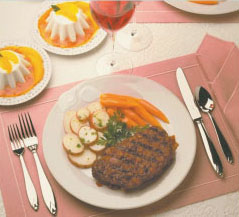 Have you seen Easter bunnies and giant Easter eggs lately? Easter is
Have you seen Easter bunnies and giant Easter eggs lately? Easter is  already on the way! I like good foods on festive seasons, be they from Beijing, Japan, Thailand, Korea or India. Buffet is my favourite as I can sample different cuisines in one meal. However, we have to understand the potential food hazards when enjoying buffets. Here are the five main risk factors:
already on the way! I like good foods on festive seasons, be they from Beijing, Japan, Thailand, Korea or India. Buffet is my favourite as I can sample different cuisines in one meal. However, we have to understand the potential food hazards when enjoying buffets. Here are the five main risk factors:
-
Preparation of too much food in a short time / preparation too early
A lot of food has to be prepared beforehand to ensure continual food supply at buffet tables. However, the prepared food will go bad easily if it is not properly kept at the right temperatures, or if it is left at room temperature for too long. -
Supply of high-risk foods
Some high-risk food items, such as oysters and sashimi which do not require cooking at high temperature, may contain pathogenic micro-organisms if they are not properly handled. -
Supply of a wide variety of foods
Cross-contamination may occur when ready-to-eat and uncooked foods are not properly handled and served at the same time. -
Prolonged Food display / consumption time
Bacteria continue to grow in food which have been displayed for too long or the meal takes a long time to finish. Some bacteria may even produce toxins. -
Contamination by customers
Customers using their hands or unsuitable utensils to get foods may inadvertently contaminate other foods.
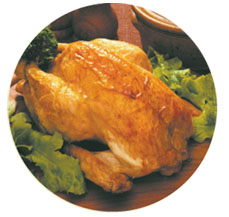 To prevent food poisoning, the following points should be noted when enjoying buffets:
To prevent food poisoning, the following points should be noted when enjoying buffets:
Are the food premises hygienic?
-
Patronise licensed food premises with good reputation;
-
Pay attention to the cleanliness of the environment and utensils of the food premises as well as the staff's personal hygiene;
-
Check whether food is properly stored and displayed. Examples are whether raw and cooked foods are properly separated and all food items properly covered;
-
Check whether there are designated staff members monitoring the cleanliness of buffet tables to avoid food contamination.
Is the food safe? 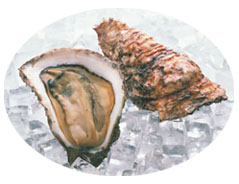
-
Do not consume food that has been discoloured or tastes abnormal as it may have spoiled;
-
Cold dishes should be kept at 4 oC or below and hot-served foods, at 60 oC or above over warming devices. If you prepare your own food , make sure they are thoroughly cooked before consumption;
-
Food should not be left at room temperature for more than two hours;
-
The elderly, children and people with low immunity should avoid consuming raw and cold foods and high-risk items such as oysters, sashimi, sushi and salads;
-
Maintain a balanced diet. Do not overindulge yourselves in eating as it may adversely affect your health.
Good consumption practices 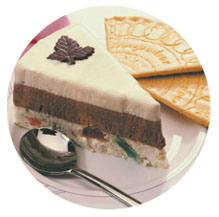
-
Wash hands thoroughly before getting food and eating them;
-
Use separate utensils such as tongs and plates provided by the food premises to handle raw and cooked foods to avoid cross-contamination;
-
Use a clean plate each time when getting food at the buffet table. Do not reuse the plate to avoid cross-contamination.
2. The Role of the World Health Organization in Food Safety
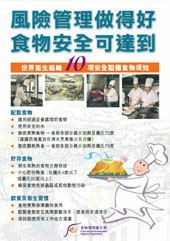 The World Health Organization (WHO) has a mandate for the protection of public health. One of its missions is the attainment of the highest possible level of health by all people. WHO's role in food safety is to reduce the burden of foodborne illness by advising and assisting Member States to reduce the pathogens and harmful chemical contaminants in food. The 1948 WHO Constitution includes specific charges relating to food safety:
The World Health Organization (WHO) has a mandate for the protection of public health. One of its missions is the attainment of the highest possible level of health by all people. WHO's role in food safety is to reduce the burden of foodborne illness by advising and assisting Member States to reduce the pathogens and harmful chemical contaminants in food. The 1948 WHO Constitution includes specific charges relating to food safety:
- assist governments in strengthening health services relating to food safety;
- promote improved nutrition, sanitation and other aspects of environmental hygiene;
- develop international standards for food; and,
- assist in developing informed public opinion among all peoples on matters of food safety.
WHO has been involved in food safety for over five decades. Many WHO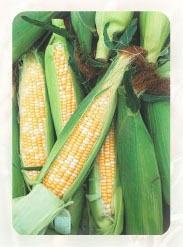 activities in this area are carried out in close collaboration with the Food and Agriculture Organization of the United Nations (FAO). In May 1963, the Joint FAO/WHO Food Standards Programme, with the Codex Alimentarius Commission (CAC) as its principal organ, was established. The main objective of CAC is to protect the health of consumers and to ensure fair practice in food trade through the elaboration of food standards contained in a food code (Codex Alimentarius). The participation of WHO was required because of its mandate for public health and food safety.
activities in this area are carried out in close collaboration with the Food and Agriculture Organization of the United Nations (FAO). In May 1963, the Joint FAO/WHO Food Standards Programme, with the Codex Alimentarius Commission (CAC) as its principal organ, was established. The main objective of CAC is to protect the health of consumers and to ensure fair practice in food trade through the elaboration of food standards contained in a food code (Codex Alimentarius). The participation of WHO was required because of its mandate for public health and food safety.
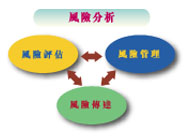 WHO's central role is a normative one and includes international standard setting and the facilitation of risk assessments. WHO has promoted the concept of risk analysis as a framework for the management of food safety. The main focus is the development of methods for quantitative microbiological and chemical risk assessment, foodborne disease surveillance and assessment of the safety of products of genetic engineering. WHO also provides technical assistance to governments, through its regional offices, to ensure a safe food supply for their populations. WHO assists national governments in developing and implementing food safety programmes and food legislation and provides support for setting up information systems for monitoring food contamination and surveying foodborne diseases.
WHO's central role is a normative one and includes international standard setting and the facilitation of risk assessments. WHO has promoted the concept of risk analysis as a framework for the management of food safety. The main focus is the development of methods for quantitative microbiological and chemical risk assessment, foodborne disease surveillance and assessment of the safety of products of genetic engineering. WHO also provides technical assistance to governments, through its regional offices, to ensure a safe food supply for their populations. WHO assists national governments in developing and implementing food safety programmes and food legislation and provides support for setting up information systems for monitoring food contamination and surveying foodborne diseases.
The Fifty-third World Health Assembly in May 2000 gave unanimous support for resolution WHA53.15 on food safety. This resolution confirmed food safety as an essential public health priority and committed WHO and its Member States to a range of multisectoral and multidisciplinary actions to promote the safety of food at local, national and international levels. It also resolved to expand WHO's responsibilities in food safety, including using limited resources efficiently to promote food safety as an essential public health function, and suggesting appropriate interventions to improve global food safety.
3. Expired Food
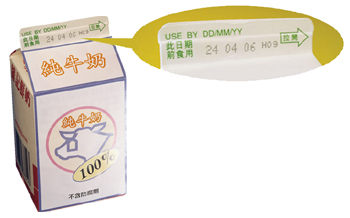 Recently, some organisations have taken samples of prepackaged food in the market and found that some had already passed their expiry dates. The community expressed much concern on the protection of food safety for the general public.
Recently, some organisations have taken samples of prepackaged food in the market and found that some had already passed their expiry dates. The community expressed much concern on the protection of food safety for the general public.
According to the Food and Drugs (Composition and Labelling) Regulations (Cap 132W), all prepackaged food should have durability indication to assist the public in making informed choices. Based on the type of food concerned, food durability indications can be marked or labelled in either of the following ways:
| "use by 此日期前食用" date - |
It is used in food items that are highly perishable from the micro-biological point of view, such as pasteurized milk, prepacked sandwiches with egg and ham, etc. as an indicator for food safety. These foods can be stored only for a relatively short time after manufacturing, and are likely to constitute a danger to human health if consumed after their "use by" date. Therefore, sale of such foods after their "use by" date is prohibited.
|
|---|---|
| "best before 此日期前最佳" date - |
An indication of food quality used for other general food items such as candies and canned beverages. The "best before" date indicates the date before which specific properties of the food, such as its colour, taste and appearance, can be maintained at optimal conditions if the food is properly stored. It does not mean that the food would necessarily perish immediately or pose a risk to human health after this date. Some foods may still retain good quality after their "best before" date.
|
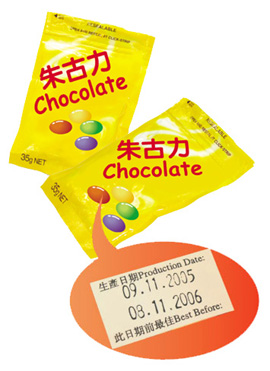 The above two types of label to differentiate and label the expiry date is not unique to Hong Kong. Many countries in the world, such as the United States, Australia, New Zealand, and the European Union, adopt similar principles to indicate the expiry date. The usual practice is to prohibit the sale of food products beyond their "use by" date, and while the sale of food products beyond their "best before" date is not illegal, vendors are required to ensure that such food products have not deteriorated.
The above two types of label to differentiate and label the expiry date is not unique to Hong Kong. Many countries in the world, such as the United States, Australia, New Zealand, and the European Union, adopt similar principles to indicate the expiry date. The usual practice is to prohibit the sale of food products beyond their "use by" date, and while the sale of food products beyond their "best before" date is not illegal, vendors are required to ensure that such food products have not deteriorated.
Different foods have different ingredients and their durability period varies. As manufacturers have the best knowledge of the specific qualities and durability of their products, the durability periods of foods on the market are determined by them.
The adoption of "use by" and "best before" dates are meant to assist the public in making informed choices with the hope to reduce waste. For foods (such as canned food products) that can be stored for a longer period, expiry of the durability period specified by the "best before" date does not mean that the foods would necessarily become unfit for consumption or pose immediate health risk upon consumption. As a result, they are treated differently under the law. While it is an offence to sell food after its "use by" date, it is not illegal to sell food beyond its "best before" date unless it is confirmed upon examination that the food has deteriorated or become unfit for human consumption.
Advice to the Public
-
Before purchase or consumption, take note of the durability period of the food items. Purchase or consumption of food beyond its "use by" date should be avoided, and food beyond its "best before" date is not advisable.
-
Do not purchase expired food for the lower price. The discomfort after consumption does not worth the money saved.
-
In addition to checking the durability period of prepackaged foods upon purchase, check also the packaging. If the packaging is damaged, the food may have been contaminated or deteriorated even though it is still within the durability period.
Food Safety Tips
Guidelines on Hygienic Handling of Ice
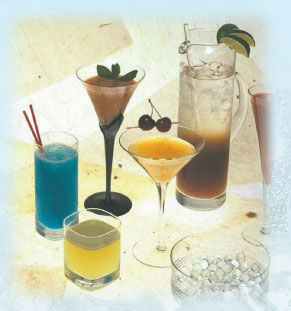 Cold drinks are no doubt the popular beverage when the weather gets warm. To keep the drink cold, we can make ice at home, or purchase ice for large gatherings with families or friends.
Cold drinks are no doubt the popular beverage when the weather gets warm. To keep the drink cold, we can make ice at home, or purchase ice for large gatherings with families or friends.
Ice making is simple but if not done properly, ice can be a vehicle to spread foodborne diseases.
Water is the basic ingredient for making ice and the water used must be potable. If boiled water is used, the ice trays must not be put into the freezer until the water has cooled down. Otherwise the heat of the water will cause the temperature inside the freezer to rise, and the foods in the freezer may perish.
 Do not make too much ice and all the ice should be used up at one time to avoid contamination due to prolonged storage. The freezer and the ice trays should be kept clean to reduce the chance of contamination.
Do not make too much ice and all the ice should be used up at one time to avoid contamination due to prolonged storage. The freezer and the ice trays should be kept clean to reduce the chance of contamination.
Ice sold on the market is mostly packaged ice. It is advisable to purchase packaged ice intended for human consumption from reliable and reputable suppliers. Upon purchase, make sure that the packages are intact and after purchase, avoid contaminating the external surface of the packages.
When transferring ice from the package into ice buckets, the following hygienic procedure should be observed:
- Clean ice buckets and the surrounding surfaces.
- Clean and dry the surface of the packages with a clean cloth.
- Use clean utensils to open the ice packages.
- When poured into ice buckets, the ice should not touch the external surface of the packages or the bare hands of the handler.
Ice storage utensils should not be used for the cooling/storage of other items (e.g. bottles of beer, cans of soft drinks or cartons of milk).
Food Safety Plan Corner
Safety Tips on Food for Take-away/Delivery
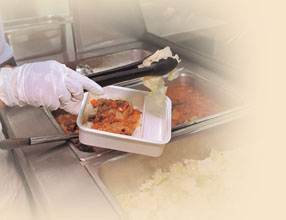 Life in Hong Kong is hectic. Food to go or food delivery is common. Sometimes people will take the leftovers home when they dine out. Delivery
Life in Hong Kong is hectic. Food to go or food delivery is common. Sometimes people will take the leftovers home when they dine out. Delivery 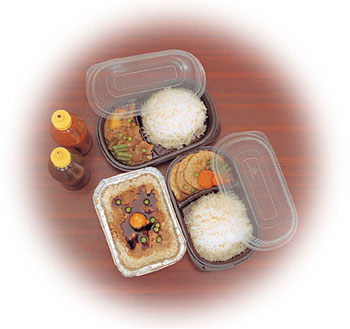 takes time and the food may not be consumed immediately. The following are safety tips to ensure the safety of take away/delivered food:
takes time and the food may not be consumed immediately. The following are safety tips to ensure the safety of take away/delivered food:
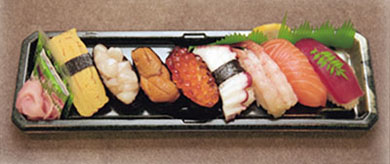 When you purchase ready-to-eat food (such as sushi, sashimi, etc.) to be served cold, bring your own ice bags with ice packs to enhance the cooling effect or ask shop assistants to put some ice on the food packages. Some sushi and sashimi shops may provide customers with ice bags. Given the difference in the cooling performance of ice bags and the variable ambient temperatures, ice bags should only be used for temporary cold storage. Avoid direct sunlight and shorten the delivery time as far as possible in order to keep the food at safe temperature (i.e. 4oC or below).
When you purchase ready-to-eat food (such as sushi, sashimi, etc.) to be served cold, bring your own ice bags with ice packs to enhance the cooling effect or ask shop assistants to put some ice on the food packages. Some sushi and sashimi shops may provide customers with ice bags. Given the difference in the cooling performance of ice bags and the variable ambient temperatures, ice bags should only be used for temporary cold storage. Avoid direct sunlight and shorten the delivery time as far as possible in order to keep the food at safe temperature (i.e. 4oC or below).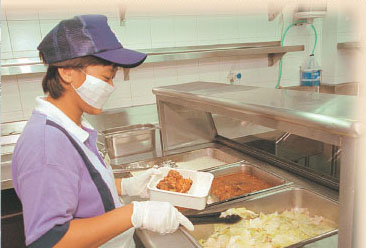
- When hot-served and cold-served foods are to go, separate them to avoid interplay between the temperatures of these foods.
- Pay attention to the temperature and cleanliness of take-away food upon collection. If in doubt, do not consume the food and check with the food premises to ensure food safety. If hot-served food is not maintained at a temperature above 60oC or cold-served food not at a temperature of 4oC or below, contact the Food and Environmental Hygiene Department (FEHD) to follow-up.
- Take-away food or leftovers from dining-out should be kept in refrigerators at 4oC or below. Avoid keeping food in the temperature danger zone (4oC to 60oC) for too long and consume it as soon as possible.
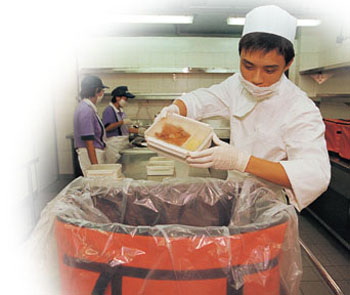
- Reheat food thoroughly until the core temperature reaches 75oC or above before consumption. Stir or rotate the food several times during the reheating process by microwave ovens to ensure even and thorough heating. Discard food (especially leftovers from dining-out) if changes in colour or smell are detected during eating or reheating.
- When dining out, order food according to the actual number of diners and their appetite to avoid wastage and ensure food safety.
Interpretation of Ordinance
Regulation 4(1) of the Colouring Matter in Food Regulations - Prohibition on the Use of Colouring Matter in Certain Commodities
Chinese have always been fastidious about food especially about its colour, aroma and flavour. In the course of food production, manufacturers may add colouring matter into food to make them more attractive or to restore their colours. Colouring matter is a kind of food additive. It is not easy to differentiate between natural and synthetic colouring matter just from the appearance of the food.
The law prohibits the use of some colouring matters in food. For instance, Sudan I and Para Red related to the food colouring incidents last year are not permitted to be added to food. Furthermore, food colours cannot be used in some kinds of food. For example, meat, vegetables, fish, etc in raw and unprocessed state are not allowed to have any added colouring matter.
Regulation 4(1) of the Colouring Matter in Food Regulations (Cap. 132H), which governs the use of colouring matter in food, provides that, "no meat, game, poultry, fish, fruit or vegetable in a raw and unprocessed state which is intended for sale for human consumption shall have in or upon it, otherwise than for the purpose of marking, any added colouring matter." However, the Regulations provides that citrus fruit may have in or upon it added permitted colouring matter if:
(a) the words "colour added" are marked on the skin of such fruit in permitted colouring matter; and
(b) such words are distinct and legible and of such size as to be conspicuously visible.
Any person who contravenes the Colouring Matter in Food Regulations shall be liable to a maximum penalty of $50,000 and imprisonment for 6 months.